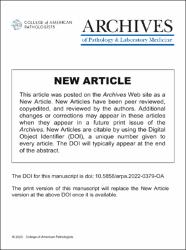Adenomyomas of the gallbladder: An analysis of frequency, clinicopathologic associations, and relationship to carcinoma of a malformative lesion

Göster/
Erişim
info:eu-repo/semantics/openAccessTarih
2023Yazar
Dursun, NevraMemiş, Bahar
Taşkın, Orhun Çiğ
Okcu, Oğuzhan
Akkaş, Gizem
Bağcı, Pelin
Balcı, Serdar
Saka, Burcu
Araya, Juan Carlos
Bellolio, Enrique
Roa, Juan Carlos
Jang, Kee-Taek
Losada, Hector
Maithel, Shishir K.
Sarmiento, Juan
Reid, Michelle D.
Jang, JinYoung
Cheng, Jeanette D.
Baştürk, Olca
Koshiol, Jill
Adsay, N. Volkan
Üst veri
Tüm öğe kaydını gösterKünye
Dursun, N., Memis, B., Pehlivanoglu, B., Taskin, O. C., Okcu, O., Akkas, G., Bagci, P., Balci, S., Saka, B., Araya, J. C., Bellolio, E., Roa, J. C., Jang, K. T., Losada, H., Maithel, S. K., Sarmiento, J., Reid, M. D., Jang, J., Cheng, J. D., Basturk, O., … Adsay, N. V. (2023). Adenomyomas of the Gallbladder: An Analysis of Frequency, Clinicopathologic Associations, and Relationship to Carcinoma of a Malformative Lesion. Archives of pathology & laboratory medicine, 10.5858/arpa.2022-0379-OA. Advance online publication. https://doi.org/10.5858/arpa.2022-0379-OAÖzet
Context.—The nature and associations of gallbladder
(GB) ‘‘adenomyoma’’ (AM) remain controversial. Some
studies have attributed up to 26% of GB carcinoma to
AMs.
Objective.—To examine the true frequency, clinicopathologic characteristics, and neoplastic changes in GB AM.
Design.—Cholecystectomy cohorts analyzed were 1953
consecutive cases, prospectively with specific attention to
AM; 2347 consecutive archival cases; 203 totally embedded GBs; 207 GBs with carcinoma; and archival search of
institutions for all cases diagnosed as AM.
Results.—Frequency of AM was 9.3% (19 of 203) in
totally submitted cases but 3.3% (77 of 2347) in routinely
sampled archival tissue. A total of 283 AMs were identified,
with a female to male ratio ¼ 1.9 (177:94) and mean size ¼
1.3 cm (range, 0.3–5.9). Most (96%, 203 of 210) were
fundic, with formed nodular trabeculated submucosal
thickening, and were difficult to appreciate from the
mucosal surface. Four of 257 were multifocal (1.6%), and
3 of 257 (1.2%) were extensive (‘‘adenomyomatosis’’).
Dilated glands (up to 14 mm), often radially converging to a
point in the mucosa, were typical. Muscle was often
minimal, confined to the upper segment. Nine of 225 (4%)
revealed features of a duplication. No specific associations
with inflammation, cholesterolosis, intestinal metaplasia,
or thickening of the uninvolved GB wall were identified.
Neoplastic change arising in AM was seen in 9.9% (28 of
283). Sixteen of 283 (5.6%) had mural intracholecystic
neoplasm; 7 of 283 (2.5%) had flat-type high-grade
dysplasia/carcinoma in situ. Thirteen of 283 cases had both
AM and invasive carcinoma (4.6%), but in only 5 of 283
(1.8%), carcinoma was arising from AM (invasion was
confined to AM, and dysplasia was predominantly in AM).
Conclusions.—AMs have all the features of a malformative developmental lesion, and may not show a significant
muscle component; (ie, the name ‘‘adeno-myoma’’ is partly a
misnomer). While most are innocuous, some pathologies
may arise in AMs, including intracholecystic neoplasms, flattype high-grade dysplasia or carcinoma in situ and invasive
carcinoma (1.8%, 5 of 283). It is recommended that gross
examination of GBs include serial slicing of the fundus for
AM detection and total submission if one is found.

















